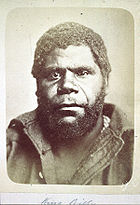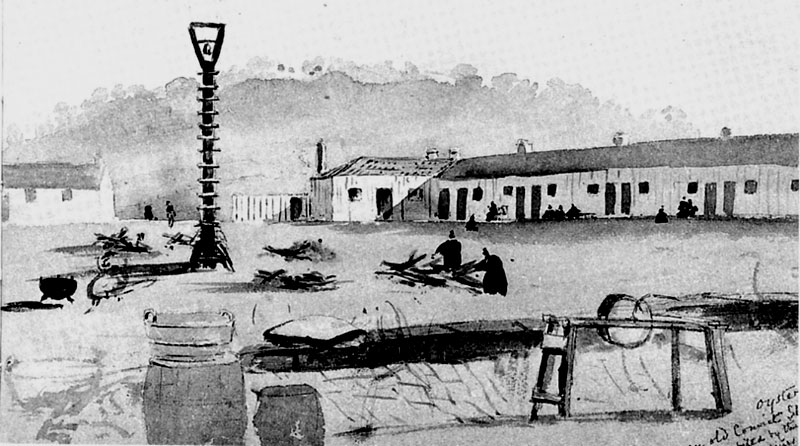
William Lanne
Encyclopedia

Australian Aborigines
Australian Aborigines , also called Aboriginal Australians, from the latin ab originem , are people who are indigenous to most of the Australian continentthat is, to mainland Australia and the island of Tasmania...
Tasmanian man.
Lanne was captured along with his family in 1842 during a period known as the Black War
Black War
The Black War is a term used to describe a period of conflict between British colonists and Tasmanian Aborigines in the early nineteenth century...
. He was the youngest child in the last family taken to the Aboriginal camp at Wybelenna on Flinders Island
Flinders Island
Flinders Island may refer to:In Australia:* Flinders Island , in the Furneaux Group, is the largest and best known* Flinders Island * Flinders Island , in the Investigator Group* Flinders Island...
by George Augustus Robinson
George Augustus Robinson
George Augustus Robinson was a builder and untrained preacher. He was the Chief Protector of Aborigines in Port Phillip District from 1839 to 1849...
. His native name is lost, probably because at 7 he was too young when arriving at Wybalenna and so the English name William he was given there stuck.
In 1847, he temporarily moved to Oyster Cove, and was sent to an orphanage in Hobart
Hobart
Hobart is the state capital and most populous city of the Australian island state of Tasmania. Founded in 1804 as a penal colony,Hobart is Australia's second oldest capital city after Sydney. In 2009, the city had a greater area population of approximately 212,019. A resident of Hobart is known as...
until 1851. In 1855 he joined a whaling ship and regularly visited Oyster Cove when he had time.
Lanne died on 3 March 1869 from a combination of cholera
Cholera
Cholera is an infection of the small intestine that is caused by the bacterium Vibrio cholerae. The main symptoms are profuse watery diarrhea and vomiting. Transmission occurs primarily by drinking or eating water or food that has been contaminated by the diarrhea of an infected person or the feces...
and dysentery
Dysentery
Dysentery is an inflammatory disorder of the intestine, especially of the colon, that results in severe diarrhea containing mucus and/or blood in the faeces with fever and abdominal pain. If left untreated, dysentery can be fatal.There are differences between dysentery and normal bloody diarrhoea...
.

Royal College of Surgeons of England
The Royal College of Surgeons of England is an independent professional body and registered charity committed to promoting and advancing the highest standards of surgical care for patients, regulating surgery, including dentistry, in England and Wales...
and the Royal Society of Tasmania
Royal Society of Tasmania
The Royal Society of Tasmania was formed in 1844.The RST was the first Royal Society outside the United Kingdom. It started as the "Tasmanian Society" formed by Sir John Franklin assisted by Ronald Campbell Gunn....
over who should possess his remains. It was reported that someone, allegedly a member of the English College of Surgeons named William Crowther
William Crowther (Australian politician)
William Lodewyk Crowther FRCS was an Australian politician, who was Premier of Tasmania 20 December 1878 to 29 October 1879.-Early life:...
, managed to break into the morgue where Lanne's body was kept and decapitated the corpse, removed the skin and inserted a skull from a white body into the black skin. The Tasmanian Royal Society soon discovered Crowther's work, and decided to thwart any further attempts to collect "samples" by amputating the hands and feet and discarding them separately. Lanne was then buried in this state.
(From David Davies, 1973 "The last of the Tasmanians", Frederick Muller, London. 235-6):
"Dr. Crowther of the hospital vainly applied to the Government for permission to send the skeleton to the Royal College of Surgeons in London. However, a rather macabre note was struck at Lanne's funeral, for it was found that the head of the corpse was missing. During the night after the burial the rest of the body was dug up and several parts removed. Crowther was blamed for the removal of the head and his honorary appointment as surgeon at the Colonial Hospital terminated, but it is interesting to note that the Council of the Royal College of Surgeons awarded him during 1869 a gold medal and a Fellowship of the College, the first instance of an Australian having been given this honour."
Although it is not known what happened to the stolen remains of Lanne, a report in The Times
The Times
The Times is a British daily national newspaper, first published in London in 1785 under the title The Daily Universal Register . The Times and its sister paper The Sunday Times are published by Times Newspapers Limited, a subsidiary since 1981 of News International...
in 1912 headed "Conversazione of the Royal Society: recent advances in science" mentions the exhibition of "the desiccated brain of an aboriginal Tasmanian"
William Lanne's name is believed to be the source of the "King Billy Pine", or Athrotaxis
Athrotaxis
Athrotaxis is a genus of two to three species of conifers in the cypress family, Cupressaceae. The genus is endemic to western Tasmania, where they grow in high altitude temperate rainforests....
, a native Tasmanian tree whose wood is renowned for its durability to rot and insects.

